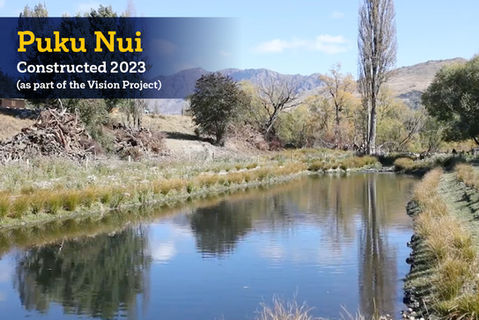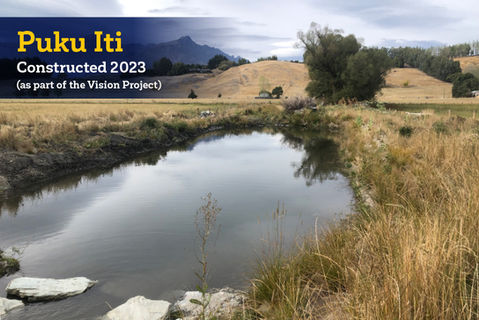
"Fix the catchment and you'll fix the lake"
SEDIMENT TRAPS:
There have been countless studies over the years on how we can improve the health of Lake Hayes, with a common theme of "fix the catchment and you'll fix the lake". With this in mind the Friends of Lake Hayes developed the “Vision Project” in 2020 to improve the water quality through-out the Lake Hayes catchment, through riparian planting together with the removal of sediment from the waterways.
Sediment entering the lake is loaded with nutrients, in particular phosphorous. Certain human-related activities (e.g. residential development, hotels, golf courses, ski-fields) have resulted in massive volumes of additional sediment entering tributaries and ultimately into Lake Hayes.
Natural ecosystems manage and control the volumes of sediment that enter waterways, through wetland systems and plant habitats. The majority of these natural systems have been drastically modified in the Lake Hayes catchment, 90% of the original wetlands no longer exist together with the clearance of the majority of vegetation.
This problem is exacerbated by the increased amount of hard surfaces introduced from development (roading and housing), which result in increased run-off during rainfall events, and the run-off is laden with sediment and other contaminants – all of which find their way into the lake.


The ORC has been measuring the sediment loads arriving at the Lake since 2020. Friends of Lake Hayes has set a target, based on historical data and lake health observation, to limit the total sediment arriving at the lake to 300 tonnes per annum. ORC provides monthly data which illustrates the volume of sediment entering the Lake, so we can track progress against this target.
The removal of sediment is made possible through the use of sediment traps. New sediment traps have been created, with the first traps being cleared of sediment earlier this year. In addition to the construction of new sediment traps, there are a large number of existing ponds throughout the catchment which are fully laden with sediment.
We have been fortunate to receive support from landowners who are now starting the process to remove sediment from their sediment traps and ponds. If the sediment is not removed, then during flood events the sediment is mobilised and washed down-stream into the Lake. It is therefore important to be regularly removing sediment that has built up in the traps and ponds.
Michael Sly who operates a successful composting venture is trialing using the nutrient-loaded sediment in his operation.
Our mission is to ensure the restoration of Lake Hayes water quality through research, catchment control and restoration.
130,000 plants, sediment traps, predator traps, fencing, weed control and much more...
Great progress has been made on restoring the wetland at the northern end of Lake Hayes between Mill Creek and Rutherford Road via the removal of exotic vegetation and replanting with natives. The restoration project represents a significant change in vegetation coverage as well as the return of indigenous flora biodiversity to the Lake Hayes catchment, a prominent recreation location within the Queenstown Lakes District. The replanting of the area will help support and enhance existing terrestrial and freshwater ecological values with an aim to significantly improving water quality, biodiversity, and habitat.
Artist's impressions (by Patch Landscape) of the final result of the Te Waiwhakaata Lake Hayes Wetland Restoration Plan...
A big thank you to Martin Barwood, who gave a presentation of his amazing photography at our AGM.
Lake Hayes is a wildlife reserve – it is awesome to see these birds living around the lake.
Please do not let your dogs roam near the bird's habitats!
You can follow Martin's work on Instagram and Facebook: (@martinbarwood)































